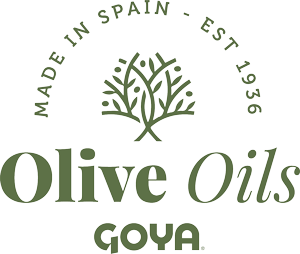FREQUENT QUESTIONS ABOUT OLIVE OIL
Olive oil is the natural juice that is extracted from the olive fruit when squeezed. It is done much in the same way as when you squeeze other fruits for juice extraction.
It depends on the variety, where it is grown and how mature the olive fruit is. Around 20% of an olive fruit is olive oil. For 1 litre of olive oil, approximately 5kg of olive fruit is needed.
- EXTRA VIRGIN OLIVE OIL. Pure olive juice with no defects in its appearance, taste, or smell.
- VIRGIN OLIVE OIL. Natural olive juice with slight defects in its appearance, taste, or smell.
- OLIVE OIL (Contains exclusively refined olive oil mixed with extra virgin olives). Goya mixes the refined oil with extra virgin olive oil, according to the amount needed to provide flavour. Goya markets it as Light Flavor or Puro.
- SECOND PRESSING OR POMACE OLIVE OIL Refined olive oil (obtained organically), mixed with virgin olive oils.
Although olive oils made up of a blend of the same types of olives do exist on the market, it is more common for an olive oil to be made up of a blend of a variety of olive types. This blend of different olive types is called “coupage”.
Our Goya Olive Oils are prepared with a blend of different EVOOs from olives harvested by hand at just the right time in the south of Spain, when all the aromatic nuances and all the flavours have been developed. That way we’re able to make sure that people are taking an Extra Virgin Olive Oil with unique and exceptional properties home with them when choosing Goya.
When tasting the extra virgin olive oil, we change the word aroma for fruit because we match the aroma to the type of fruits and their maturity levels. There is distinction between the types of olive fruit:
- UNRIPE FRUIT: This fruitiness should be reminiscent of the colour green, unripe fruits, grass, leaves, freshness, natural and clean smell, etc…
- RIPE FRUIT: This oil will be reminiscent of ripe fruits. The most common aroma that reminds us of ripe banana.
- From green olives, the oil has a GREEN colour.
- From olives that change colour, the oil is GOLDEN.
- From black olives, the oil has a YELLOW colour.
It means that the extra virgin olive oil developed using cold extraction, i.e., the temperature of the mass from which they are obtained does not exceed 27ºC (80.6ºF).
The disadvantage of the mass being at 27ºC (80.6ºF) is that there is a percentage of oil that is not extracted. This results in higher production costs. To avoid this, the extraction temperature is usually raised, which is detrimental to the oil’s quality.
There is no expiration date, but it is recommended to consume within 2 years. If you were to consume olive oil that is more than 2 years old, no harm would be done, but there would be a noticeable deterioration in its quality due to the oxidation process resulting in the presence of secondary reaction products. This is when it stops being extra virgin olive oil.
There are three main components to consider when storing olive oil:
- Light (it activates and catalyses the oxidation process).
- Oxygen (it causes the oil to oxidise).
- Temperature (high temperatures are favourable conditions for peroxide formation, which also causes oxidation).
To reduce oxidation and its negative effects on olive oil, Goya substitutes oxygen found in the space at the head of the bottle with nitrogen (an inert gas). It is recommended to store the olive oil in a fresh space away from direct light.
Acidity is a quality control measured by the amount of oleic acid present. It is necessary to carry out a chemical analysis to know how much there is.
The current law legislates that the maximum level of acidity for an oil to still be considered extra virgin cannot go over 0.8% (oleic acid). Although it is not a rule, it is generally considered that the lower the acidity of an oil, the less likely it is for there to be imperfections in the oil’s appearance, taste, and smell.
The normal value for a good extra virgin olive oil is usually <0.4%. A GOYA® Extra Virgin Olive Oil is usually much below this level of acidity.
Extra virgin olive oils are ideal for:
- Drizzling over a light salad or Spanish tostada.
- Stews.
- Garnishes.
Both extra virgin olive oil and olive oil (GOYA® Light Flavor and Puro) are recommended for frying. Thanks to their high stability and resistance to oxidation and high temperatures, they can be reused more often than seed oil.
GOYA® Puro and Light Flavor olive oils have little aroma and a smooth taste. It can be used as a garnish over foods, although it will add little smell and flavour.
The ideal olive oil for the consumer is the one that presents harmony and balance, between the intensity of fruitiness, bitterness, and pungency of the oil.
There are polyphenols (natural antioxidants) found in extra virgin olive oil. They are the reason the oil has a spiciness and bitterness. Polyphenols do not have any nutritional value (calorie free), but they do have health benefits.

